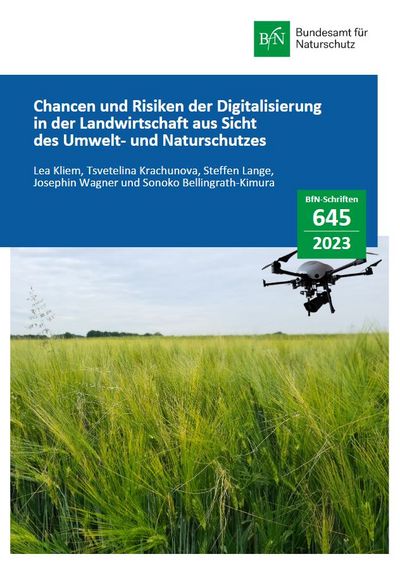Opportunities and risks of digitalization in agriculture from the perspective of environmental protection and nature conservation
Digital technologies or applications are already being used on many German farms. These include driver assistance systems, (ground) sensor networks, intelligent data management systems, dronebased image recognition systems and GPS-controlled agricultural robots. The digitalization of the agricultural sector holds both potentials and risks for biodiversity conservation.
Increased resource efficiency can reduce fertilizer, chemical use, and greenhouse gas emissions. Improved monitoring and tracking of environmentally related data can also facilitate biodiversity-enhancing measures. Smaller field robots can reduce soil compaction and enable more complex cropping systems with higher agrobiodiversity. However, there is a lack of analysis on the magnitude of effects attributable to the use of digital applications.
There is also a risk that digital technologies will contribute to the further intensification of agricultural systems and thus impede a sustainability-oriented transformation of agriculture. The production and use of digital technologies themselves also require energy and materials. Higher efficiency can lead to rebound effects, which would counteract savings. In addition, the hoped-for resource savings in small and medium-sized enterprises may fail to materialize due to high administrative hurdles. On a socio-economic level, the risks seem to outweigh the benefits. In particular, there is a tendency towards infrastructural, economic and market concertation, which may also have ecologically negative effects such as the homogenization of farming systems.
Our analysis shows that the preservation of biodiversity and ecosystems is currently not a primary goal of the digitalization of agriculture but is merely a possible side effect. Overall, there is a significant gap between the theoretically possible benefits and the empirical observation. The potentials of the digitalization for biodiversity conservation tend to be neglected and are likely to remain unused since they are so far not profitable. Furthermore, digitalization, in turn, gives rise to new, different challenges and risks. Technological developments such as precision agriculture, smart farming, and Agriculture 4.0 should hence be seen as tools that can help spread biodiversity-enhancing approaches. However, they do little to fundamentally transform industrialized agricultural systems and may even inhibit a larger agroecological transformation. Consequently, strategic governance of the digital transformation of agriculture is necessary to exploit promising potentials for biodiversity conservation and mitigate potential risks.



